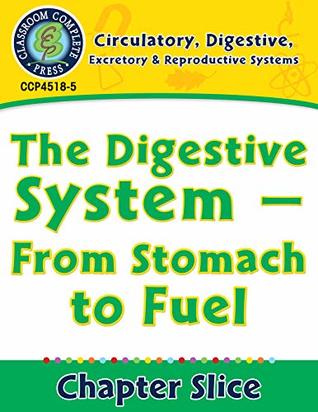Read Online Circulatory, Digestive & Reproductive Systems: From Stomach to Fuel Gr. 5-8 - Susan Lang file in PDF
Related searches:
1536 1722 2732 4318 4310 1718 3755 3059 4118 1400 3354 891 1837 2877 3670 191 4916 2363 893 3681 1937 1040 4492 1023 4577 997 2480 4812 2873 400
The circulatory system helps move glucose out of the digestive tract and into the body cells.
Digestive system respiratory system circulatory system protection for impulses sent down through the body from the brain.
The digestive system consists of the pharynx, the esophagus, the crop, the intestine and the gizzard.
The circulatory system moves nutrients broken down by the digestive system. Like many parts of the body, the digestive system and circulatory system are related in a number of integral ways. When most people think of the circulatory system, they picture the heart and lungs acting to pump blood throughout the body.
The circulatory system the circulatory system transports blood through the human body. Blood delivers waterand nutrients from the digestive system, and oxygen from the respiratory system, to all cells in the body. Blood also carries wastes from body cells to the organs that remove wastes.
When it comes to digestive and circulatory systems, they both process and transport essential nutrients your cells need to fuel your body. After you eat, your digestive system breaks carbohydrates into simple sugars like glucose. The bloodstream absorbs glucose, which your circulatory system distributes throughout the body.
The circulatory system is needed to transport nutrients from the digestive system and respiratory system about the rest of the body, but without the nutrients, the heart could not beat.
[h]digestion, circulation, respiratory system fill-in-the-blanks quiz _____ flows from the cells of the body, to the circulatory system, to the respiratory system�.
The circulatory system then carries oxygen to all the cells in the body and picks up carbon dioxide waste, which it returns to the lungs. Carbon dioxide diffuses from the blood into the lungs, and you exhale it into the atmosphere.
There are eleven systems in the human body: muscular system, respiratory system, digestive system, integumentary.
This short film offers a look at respiration and a tour around the circulatory system and digestive system in the human body, through blood vessels and into.
The circulatory system is your heart and blood vessels, and it’s essential to keeping your body functioning. This finely tuned system carries oxygen, nutrients, electrolytes, and hormones.
There are eleven different organ systems in the human body: circulatory, digestive, endocrine, excretory (urinary), immune, integumentary (skin), muscular�.
Blood plays a large role in digestion and endocrine system functions.
Your circulatory system, also known as your cardiovascular system, is made up of your heart and blood vessels. It works to transport oxygen and other nutrients to all the organs and tissues in your.
A body system is a group of organs that work together to perform a specific function. The systems studied in elementary school are usually the circulatory system, respiratory system, muscular system, digestive system, and nervous system.
Systems: the circulatory system is the system consisting of your heart and blood vessels. This system transports oxygen and nutrient to the body and waste products to the organs that eliminate them. The digestive system is where oral intact is broken down into absorbable particles.
Digestive system breaks food down into nutrients such as glucose. Carbon dioxide oxygen (from respiratory system) (to respiratory system) water usable energy now the circulatory system enters the picture. It transports glucose and other nutrients from the digestive system to the cells.
The human body is a dynamic system continuously processing nutrients, wastes, and gases. This lesson identifies the organs and processes involved in digestio.
For example, the digestive system is specialized for efficiently extracting useful nutrients from food. Similarly, the respiratory system deals with the exchange of gases, while the nervous and endocrine systems are involved in coordination and homeostasis. In order to sustain each of these organ systems, the body needs a circulatory system.
The digestive system converts bulk foods like bread and meat into their components, and absorbs them into the bloodstream through the intestines.
The respiratory, circulatory, digestive, and excretory systems deliver oxygen and nutrients and remove wastes.
Fill it in with the function of the systems in the human body and the organs involved in each system.
Jan 19, 2019 - explore ada a's board circulatory digestive system project on pinterest. See more ideas about digestive system project, human body systems,.
The circulatory system is the system that pumps blood through the blood body. It consists of the heart, blood vessels, blood, lymph, lymphatic vessels and glands.
The hepatic portal vein delivers materials from these digestive and circulatory organs directly to the liver for processing. Because of the hepatic portal system, the liver receives its blood supply from two different sources: from normal systemic circulation via the hepatic artery and from the hepatic portal vein.
Organ systems, such as the digestive system, are collections of organs that that involves the integration of skin, muscular, nervous, and circulatory systems.
What part of the digestive system is this and� what does it use mechanical or chemical� answer choices.
5: identify and investigate the general functions of the major systems of the human body (digestive, respiratory, circulatory, reproductive, excretory, immune, nervous, and musculoskeletal) and describe ways these systems interact with each other to maintain homeostasis.

Post Your Comments: